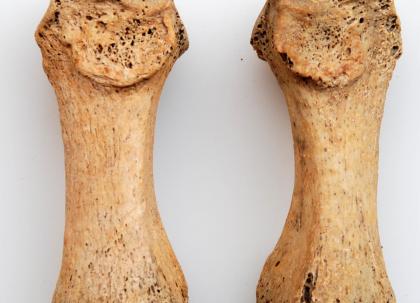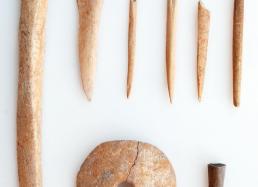12: What We Learn from Bones
One of the fun parts of our weeks in the lab for me is what our specialists learn and can tell me through their studies of the animal bone and bone tools (which are analyzed by Dr. Heather Lapham) and human bone (which are analyzed by Lindsey Cadwell Baker). In this dispatch, I highlight a few of their results, which provide a window into the insights that these remains can give us when placed in a broad context with the findings from the other materials examined.
Over our three seasons of excavation at the Mitla Fortress, the 48 burial contexts we’ve found (a good number of these included more than one individual, such as the tomb we found in 2011) have yielded clear support for our interpretation that this site, with its famous stone walls at the apex, was much more than a military garrison.
Over the years, many of the burials that we’ve recovered during our excavations are women and children. The consistent representation of these population components throughout all time periods of the occupation provides support (in concert with our domestic excavations) that this site was principally a town for domestic families.
Lindsey’s analysis of the bones from two of the adult women in this season’s burial population also found further evidence of the bodily injuries or work-related stresses that affected some prehispanic Zapotec women. These two women had “kneeling facets” (a component of arthritis), evident as extra bone growth on certain toe bones (see above photo.)
The facets are caused when women kneel, sitting on the backs of their feet, while they grind tortillas and/or weave. Doing this for a lifetime, the women wear down the cartilage in their feet, so that bone rubs against bone, resulting in the growth. We’ve recorded such facets at El Palmillo and also for some of the female individuals that we found during previous seasons at the Fortress. Never have we noted such facets on the toes of men.
The study of animal bones from Terrace 276 also revealed a number of fascinating results. In line with our hypothesis that the occupants of Terrace 276 were slightly less well off than the inhabitants of the terraces we studied in 2009 and 2010, we recovered less animal bone overall than in the previous years. (We already mentioned in a prior dispatch that few offerings or burial offerings were composed of animals, and most were just ceramic.)
Although bone tools were as common on Terrace 276 as in the terraces excavated in the previous two years, a slightly higher percentage of these tools were made of human bone. Did the use of human bones to make tools reflect a relative dearth of appropriate animal bone for making tools on this terrace?
The bone tool assemblage on Terrace 276 also was not precisely like the assemblages we recovered on Terraces 56-57. This year, we appear to have more bone tools with pointed ends (where the tool was used). We call these tools “perforators” (see Photo #1 below), and one idea is that they were to process agave plants into (ixtle) fiber. In contrast, we noted fewer bone battens, used for weaving, than we observed on the two higher terraces studied during 2009-2010.
In line with the lower socioeconomic status of the Terrace 276 residents (compared to the inhabitants of Terraces 56-57), we recovered more turtle bones but fewer turkey and dog bones. Turkey and dog were two of prehispanic Mexico’s three domestic animals (the third was the honey bee, although a case might also be made for rabbits).
Domestic animals served as a banking mechanism for periodic food surpluses, providing a kind of insurance against hard times. Because they required extra resources, and because they weren’t necessarily efficient in a caloric sense, domestic animals and the practice of raising domestic animals may likely be associated with households that were somewhat better off.
Alternatively, turtles may have been easy to catch near springs at the base of the Fortress. Several older workmen have told me over the years that, decades ago, turtles actually were rather abundant at these springs, at least during specific times of the year. Given the opportunistic nature of securing turtles and the relatively small amount of meat this variety provides, the association of this species with the lower-status folks who lived on Terrace 276 is not surprising.
The findings from these studies are instrumental to our overall analyses and add much to what we can say about the history of the people who lived at the Mitla Fortress and how their lives varied across the site and over time.
More soon,
Gary







